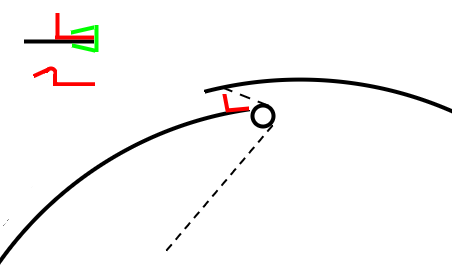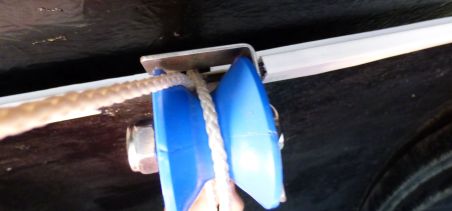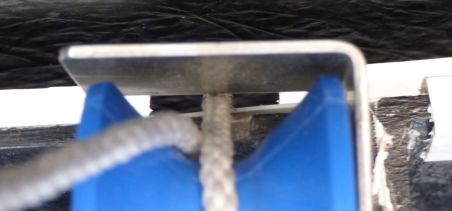 |
Here I try to illustrate my first solution. The main part of the diagram shows an enlargement of the section of the cross-section where the shutter overlaps the base dome see Page 1. I have also included the pulley and, as a dashed line, the closing chord because this is a significant aspect of the implementation. All this is shown in black.
In red is a piece of plastic angle section, placed across the full width of the opening with one edge lined up with the edge of the dome. This is held in place as shown in green in the insert in the upper-left corner of the diagram. The green piece is two pieces of poster hanger, one each side of the pulley. This acts as a convenient plastic spring clip.
|
Finally I had to consider the chord that closes the shutter. This passes over the pulley and attaches to the end of the shutter. When it is open, this chord passes down the gap between the dome and the shutter and it has to pass over the barrier. Left as described so far the chord would rub on the edge of the plastic strip with a risk of it wearing through. If it were to break with the shutter only partly closed, it would fall back to its open position and I would have quite a problem closing it. To try to prevent the chord chafing as it passes over the plastic strip, I cut the strip down to about ⅔ of its width on either side of where the chord runs and bent the small piece over to form the shape shown in the lower insert in the diagram above.


|
It is almost impossible to photograph the modification in place. However here are two attempts.
This one is a wide view in which you can see the end of one clip, just to the right of the pulley. There is another to the left of the pulley. The barrier is the white line just above the clip.
This lower picture shows a closer view of the pulley and you can just see the slot through which the chord passes. It is wider than it really needs to be.
|
I may never know how well this idea works. Indeed if it works really well I will never know. If it doesn't work then I will eventually find out. There are inevitable gaps at each end of the barrier, and the wind will find a way in if it is determined to do so, and it may drive the water with it. My hope is that a thin layer of water moved up the surface of the dome and just overflowed at the edge and the barrier will effectively prevent this, or at least reduce it. We will see. Meanwhile I will keep an eye on the weather forecast and try to keep the dome pointing into the wind.
I only had this idea installed for a couple of months and no rain got in in that time. However I, and some others who had seen this page, felt that rain might still get in as the wind would find a way. So having waited three weeks for the manufacturer's solution, I decided to go ahead with my second idea.
Home
Equipment Observatory Page 1 Page 3 Page 4 Page 5 Page 6




